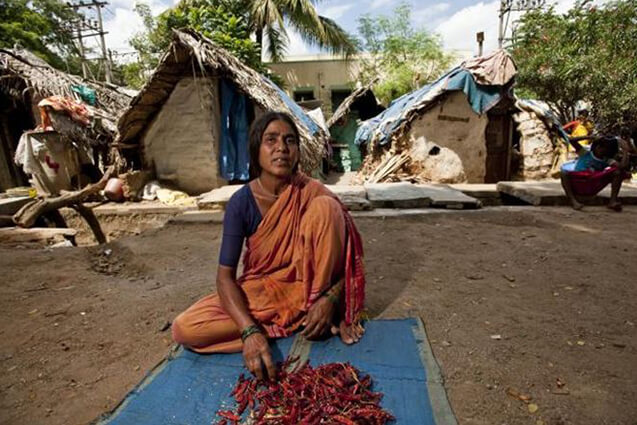Food Security Ordinance – analysis and recommendations
 Author: Byomkesh Lal
Author: Byomkesh Lal

A couple of months ago, The Honorable President of India promulgated an Ordinance on the National Food Security that seeks to give legal rights to 67 per cent of the population over subsidised grains every month.
The detailed version of ordinance can be found here. The beneficiaries will be identified by the States, which will also implement the programme under the Targeted Public Distribution Scheme.
The ordinance will have to be ratified within six weeks of the commencement of the next session of Parliament. As we prepare this note, the monsoon session of the parliament has just begun and this is certainly one of the most important of issues to find its space in the discussions at the high hbe debated in this session.
It is also important to note that in the election promises of United Progressive Alliance in 2009, ensuring Food security within 100 days of second-tenure, was high on the list. We are almost at the end of that tenure before the discussion has finally reached the parliament.
The food security act could have been a culmination of the long struggle to ensure a hunger and malnutrition free India.
However, in its present form, the Ordinance is being opposed by the Right to Food Campaigners (constituting a large number of grass-root organizations across India) on various counts.
The suggestions made by the campaigners include a further increase of entitlements that are being proposed as well as a broadening of the scope of the concept of ‘right to food’ itself, so as to include crucial issues such as land, agriculture and water.
It needs to be noted that, all this is happening in a situation where certain vested interests have stepped up their campaign in reducing the problem of mal-nutrition in India to an an illusory one, resulting from bad measurement!
There have been strong criticisms about the government taking the ordinance route on an important issue like the Food Security. Some have even termed it a way of short-circuiting informed debate in the parliament.
An ordinance is an executive order to pass laws when Parliament is not in session. It remains effective for six months from the date of passage within which period it must be replaced with a permanent law that needs to be passed by both houses of Parliament.
However, various criticisms notwithstanding, the fact remains that even in its somewhat limited scope, this Ordinance is a groundbreaking one and will have a positive impact across the nation.
It could be seen as a first step towards the ultimate goal of a comprehensive (and universal) food security act. Experts also believe that access to subisidized food would help the poor beneficiaries save on food expenditures and leave more disposable income in the hands of the beneficiaries to do more spending on health and education.
In this context, it becomes exceedingly important that ActionAid India through its partners and ongoing campaigns take a proactive stand supporting the broad advocacy positions of the nationwide Right to Food Campaign, and its efforts to convince the government to make positive revisions in the Ordinance and incorporate a specific timeframe for implementation.
LIMITATIONS OF THE CURRENT VERSION
The Ordinance’s narrow vision on the prerequisites of food security, restricted mainly to grain entitlements under the existing Public Distribution System, need to change significantly.
According to NCRB data, more than 2,50,000 farmers have committed suicide after 1995 in rural India. In this situation, a right to food legislation that does not address the ongoing agrarian crisis in the countryside will remain severely limited in its scope.
In addition, it is observed by various advocacy groups across the country that the focus of the legislation remains only on the access and availability aspects of the right to food and not on the nutritional dimension.
More worryingly, important social determinants like access to healthcare, drinking water, sanitation, etc have been completely ignored.
There are fears expressed from various quarters that commercial interests will be encouraged in the procurement and distribution of food entitlements in contravention to many existing Supreme Court orders.
It is indeed a grave situation and the ‘Right to Food Campaign’ needs to be strengthened with mobilization of people and opinion around the issue, so that the problem of hunger is addressed by the government at a more fundamental level.
We endorse the various issues raised by the Right to Food Campaign in its recent press release which urged the UPA government to bring the Ordinance through only after sufficient debate and discussion in Parliament.
RECOMMENDATIONS
The broad aspects of the National Food Security Ordinance that need attention are listed out below:
- PRODUCTION & PROCUREMENT ISSUES: The ordinance, even if it eventually becomes an Act, will remain a food entitlement Act and not legislation in line with the right to food. It fails to address the production or procurement related issues, issues related to relief to farmers, or the larger determinants to right to food. It must be noted that the key social determinants to malnutrition are left out completely from the legislation.
- ENDANGERING PDS? – Even though UPA-2 promised to bring in a law that would ensure every household received at least 35kg of grain per month from the public distribution system, the current ordinance does not propose any return to universal PDS. Instead, it now creates a new classification that puts the cut-off at 67 per cent. No more than 75 percent of the rural households, and 50 per cent of the urban households, can come under the ambit of right to food.
- REALISTIC TIMELINES TO MAP ELIGIBILITY: Section 10 of the ordinance which discusses the identification of the eligible households mandates the state governments to identify the eligible households within 180 days after the commencement of the Ordinance. It is ironical when the central government has taken nearly 2 years to complete the socio-economic and caste survey (still not over) and expects states to identify the eligible households in a period of 180 days. Hurrying the beneficiary identification process will defeat the purpose of the Ordinance to provide food security to the poorer section of the population.
- RISKS OF UNFAIR EXCLUSION: These households will get only 5 Kg foodgrains per person per month and not 35Kg per household per month as promised before. The rest of the households are totally excluded from entitlements under PDS, and will have no right to food. Such targeting are indeed prone to well-known errors of unfair exclusion and unjustified inclusion. What we need is a PDS free of all arbitrary cut-offs, and which is truly universal. It needs to be kept in mind that the ICMR norms recommend that an adult requires 14kgs of food grains per month. The minimum requirement of a person must be taken into account while the allocation of food grains is determined.
- SECTION 32 IS WELCOME: The ordinance says that State governments, if they want, can increase the coverage at their own cost. This is both meaningless and unfair to those State governments that already run a widespread, near-universal and efficient PDS like Tamil nadu, Kerala, Chhattisgarh and Orissa. It is feared that this legislation will affect the price at which the centre sells grain to the states, and those already with larger programmes will end up having to buy from the open market to top up their requirements. However, section 32 of the ordinance is a welcome step which states that this legislation does not preclude the state and central government from continuing or formulating other food based welfare schemes.
- ENSURE LOCAL PRODUCTION: Section 23 of the ordinance which allows for fund transfer from the centre to states in situations of short supply of foodgrains is problematic, as it paves way for the central government to abdicate its responsibilities regarding foodgrain production. A situation where the changing climate makes food deficit years and drought years a recurring possibility, it would encourage a minimalist state buying its way out of a strong presence in agriculture. Rather, the central government should discuss and collectively work out a strategy and operational plan to ensure local food grain production. All the programmes/Missions on agriculture/ food production such as RKVY, NFSM, MHM, etc. may be propelled in line of the Ordinance to realize the objective of food security in a time bound manner.
- ADDRESS VULNERABLE GROUPS: The legislation has left out special provisions for marginalized groups whose access is severely compromised which were addressed –albeit partially- in the previous versions of the Ordinance, whittled down subsequently. Section 30 of the ordinance which discusses needs more clarity in terms of government’s commitment to pay special focus to the needs of vulnerable groups residing in remote and difficult to access, hilly and tribal areas for ensuring their food security. Unless these groups are identified as eligible beneficiaries of this ordinance, they would not be able to benefit from this.
- MID-DAY MEAL DURING HOLIDAYS: Section 5b of the ordinance talks about food and nutritional security of children up to class VIII. It should also provide free mid day meal during holidays in the case of drought declaration/ humanitarian emergencies like floods, and other natural calamities when the poor households need it the most.
- DIRECT CASH TRANSFER DETRIMENTAL: The food security allowance’s provision made in the ordinance is problematic. There is well-founded apprehension that the government, in the long run might abdicate the responsibility of supplying food grains and resort to cash transfers which would leave the poor beneficiaries at the mercy of the market forces. The clauses that allow for direct cash transfers in the place of food grains should be removed. Also, there is the risk of such a move undermining the production/yield potential of our farming community in the country whose farming rights and entitlements we have been relentlessly demanding for.
- ADDRESS NUTRITION ISSUES: The Section 31 of the Ordinance which discusses provisions for advancing food security remains quite sketchy and unclear about the measures to be taken to progressively realise the objectives of advancing nutritional and food security in the Schedule III of the Ordinance. It seems that to pacify the demands of the farmers’ organizations and the national campaign, the schedule has been written in a vague manner without mention of any commitment from the central government to protect the rights of the farmers and to address the plundering of resources like land, water and commons.
- DECENTRALISE GRIEVANCE REDRESSAL: The grievance redressal system mentioned in the ordinance places officials at district level, whereas the vast coverage of the Ordinance calls for further decentralizing the process of grievance redressal by placing adequate number of human resource even at the panchayat level.
ActionAid India has been in complete solidarity with the nationwide movement for the Right to Food, over the last decade or so. We have been an active part of the campaign demanding a comprehensive food security act – both at the national level and in terms of state level initiatives and public action.
Our partners and various peoples’ formations promoted and supported by us have been strengthening the campaign across the country.
We urge everyone to be part of the public debates and campaigns that aim at strengthening the Ordinance, and help make this historic legislation more inclusive and responsive.
(The author wishes to acknowledge the contributions made by Oommen in preparing this note. You can contact the author at byomkesh.lal@actionaid.org)



